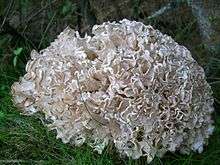Sparassis
| Cauliflower mushroom | |
|---|---|
 | |
| Sparassis crispa | |
| Scientific classification | |
| Kingdom: | Fungi |
| Division: | Basidiomycota |
| Class: | Agaricomycetes |
| Order: | Polyporales |
| Family: | Sparassidaceae |
| Genus: | Sparassis |
| Type species | |
| Sparassis crispa Fr. | |
| Species | |
|
See text. | |
Sparassis (also known as cauliflower mushroom) is a genus of parasitic and saprobic mushrooms characterised by their unique shape and appearance. This appearance can be described as similar to a sea sponge, a brain, or a head of cauliflower, from which it has been given its popular name.
They are increasingly cultivated and being sold in Korea, Japan, United States and Australia.
The generic name comes from the Greek sparassein meaning to tear.[1]
Species

There are seven species in the genus:[2]
- Sparassis crispa (Wulfen) Fr.
- Sparassis brevipes Krombh.
- Sparassis cystidiosa Desjardin & Zheng Wang[3]
- Sparassis latifolia Y.C. Dai & Zheng Wang[4]
- Sparassis miniensis Blanco-Dios & Z. Wang[5]
- Sparassis radicata Weir
- Sparassis spathulata (Schwein.) Fr.
The best-known and most widely collected species of Sparassis are S. crispa (found in Europe and eastern North America) and S. radicata (found in western North America). These species have a very similar appearance and some authorities treat them as conspecific. Their color can range from light brown-yellow to yellow-grey or a creamy white cauliflower colour. They are normally 10 to 25 cm tall, but can grow to be quite large, with reported cases of fruiting bodies more than half a meter tall and 14 kg in weight. Because of their unique look and size, they are unlikely to be mistaken for any poisonous/inedible mushrooms. They grow as parasites or saprobes on the roots or bases of various species of hardwoods, especially oak, and conifers, and hence are most commonly found growing close to fir, pine, oak or spruce trees.
Edibility
Sparassis crispa can be very tasty, but should be thoroughly cleaned before use, as the folds can contain dirt and other material, as it grows and envelops objects around it such as pine needles. Antonio Carluccio reports that European Sparassis crispa should be picked when creamy white, and once yellow are too indigestible to eat. It is good for drying and reconstituting, as it retains its cartilaginous texture and hence is good for soups.[6]
Experiments suggest that S. crispa contains chemicals which may stimulate the immune system and have anti-tumor properties.[7]
See also
References
- ↑ sparassis at dictionary.com
- ↑ Light W, Woehrel M (2009). "Clarification of the nomenclatural confusion of the genus Sparassis [Polyporales: Sparassidaceae] in North America" (PDF). Fungi. 2 (4): 10–15.
- ↑ Desjardin DE, Wang Z, Binder M, Hibbett DS (2004). "Sparassis cystidiosa sp. nov. from Thailand is described using morphological and molecular data" (PDF). Mycologia. 96 (5): 1010–4. doi:10.2307/3762085. PMID 21148922.
- ↑ Dai YC, Wang Z, Binder M, Hibbett DS (2006). "Phylogeny and a new species of Sparassis (Polyporales, Basidiomycota): evidence from mitochondrial atp6, nuclear rDNA and rpb2 genes" (PDF). Mycologia. 98 (4): 584–92. doi:10.3852/mycologia.98.4.584. PMID 17139851.
- ↑ Blanco-Dios JB, Wang Z, Binder M, Hibbett DS (2006). "A new Sparassis species from Spain described using morphological and molecular data" (PDF). Mycological Research. 110 (Pt 10): 1227–31. doi:10.1016/j.mycres.2006.07.012. PMID 17018255.
- ↑ Carluccio A. (2003). The Complete Mushroom Book. Quadrille. ISBN 1-84400-040-0
- ↑ Harada T, Ohno N (2008). "Contribution of dectin-1 and granulocyte macrophage-colony stimulating factor (GM-CSF) to immunomodulating actions of beta-glucan". International Immunopharmacology. 8 (4): 556–66. doi:10.1016/j.intimp.2007.12.011. PMID 18328447. Retrieved 2010-12-31.
Further reading
- Burdsall HH, Jr. 1988. Type studies and nomenclatural considerations in the genus Sparassis. Mycotaxon 31:199–206.
- Wang Z, Binder M, Dai Y-C, Hibbett DS. 2004. Phylogenetic relationships of Sparassis inferred from nuclear and mitochondrial ribosomal DNA and a protein-coding gene (rpb2). Mycologia 96:1013-1027.
- Kiyasko AA, Zmitrovich IV. 2013. Red Book of Kabardino-Balkaria Cherkessk:210.
External links
- Sparassis in Index Fungorum
- "Sparassis crispa: The Cauliflower Mushroom" by Michael Kuo, MushroomExpert.Com, June 2003.